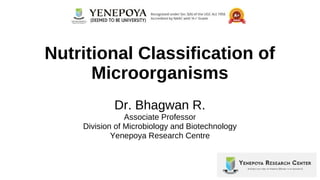Nutritional classification of microorganisms
•
0 likes•26 views
Microbiology
Report
Share
Report
Share
Download to read offline

Recommended
Recommended
More Related Content
Similar to Nutritional classification of microorganisms
Similar to Nutritional classification of microorganisms (20)
Copyright © 2011 Pearson Education Inc.Copyright © 2.docx

Copyright © 2011 Pearson Education Inc.Copyright © 2.docx
Copyright © 2011 Pearson Education Inc.Copyright © 2

Copyright © 2011 Pearson Education Inc.Copyright © 2
Physiology of Bacteria. Type & Mechanism of Bacteria Nutrition 

Physiology of Bacteria. Type & Mechanism of Bacteria Nutrition
Effect of Different Nutrients on Bacterial Growth.pptx

Effect of Different Nutrients on Bacterial Growth.pptx
Recently uploaded
Mehran University Newsletter is a Quarterly Publication from Public Relations OfficeMehran University Newsletter Vol-X, Issue-I, 2024

Mehran University Newsletter Vol-X, Issue-I, 2024Mehran University of Engineering & Technology, Jamshoro
Recently uploaded (20)
ICT role in 21st century education and it's challenges.

ICT role in 21st century education and it's challenges.
Salient Features of India constitution especially power and functions

Salient Features of India constitution especially power and functions
Basic Civil Engineering first year Notes- Chapter 4 Building.pptx

Basic Civil Engineering first year Notes- Chapter 4 Building.pptx
Plant propagation: Sexual and Asexual propapagation.pptx

Plant propagation: Sexual and Asexual propapagation.pptx
NO1 Top Black Magic Specialist In Lahore Black magic In Pakistan Kala Ilam Ex...

NO1 Top Black Magic Specialist In Lahore Black magic In Pakistan Kala Ilam Ex...
Sensory_Experience_and_Emotional_Resonance_in_Gabriel_Okaras_The_Piano_and_Th...

Sensory_Experience_and_Emotional_Resonance_in_Gabriel_Okaras_The_Piano_and_Th...
ICT Role in 21st Century Education & its Challenges.pptx

ICT Role in 21st Century Education & its Challenges.pptx
HMCS Vancouver Pre-Deployment Brief - May 2024 (Web Version).pptx

HMCS Vancouver Pre-Deployment Brief - May 2024 (Web Version).pptx
Kodo Millet PPT made by Ghanshyam bairwa college of Agriculture kumher bhara...

Kodo Millet PPT made by Ghanshyam bairwa college of Agriculture kumher bhara...
Fostering Friendships - Enhancing Social Bonds in the Classroom

Fostering Friendships - Enhancing Social Bonds in the Classroom
Nutritional classification of microorganisms
- 1. Dr. Bhagwan R. Associate Professor Division of Microbiology and Biotechnology Yenepoya Research Centre Nutritional Classification of Microorganisms
- 2. Specific learning objectives 1. To become familier with nutrion requirements of microorganisms 2. To understand difference between microorganisms based on their nutrion requirement or habit or habitat
- 3. organisms.
- 7. Nutritional types of microorganisms (M.O.) M.O. can be classified into nutritional classes based on how they satisfy all their requirements (C, H, O, energy and electrons). There are two sources of energy available to M.O:
- 10. Light energy & Energy derived from oxidizing organic or inorganic molecules. 1. Phototrophs: M.O that use light as their energy source. 2. Chemotrophs: M.O obtain energy from the oxidation of chemical compounds (organic & inorganic molecules).
- 11. Classification of M.O according to their source of electrons 1- Lithotrophs: reduced inorganic substances as their electron source. 2-Organotrophs: extract electrons from organic compounds. According to carbon sources, M.O can be divided into two groups 1-Autotrophs; CO2 sole or principal biosynthetic carbon source. 2-Heterotrophs; Reduced, preformed, organic molecules are their carbon sources.
- 12. Major Nutritional Types Most M.O may be placed in one of four nutritional classes based on their primary sources of carbon, energy, and electrons: 1-Photolithoautotrophy: L/E, Inorganic H/Electron donor; CO2 2-Photoorganoheterotrophy: L/E, Organic H/Electron donor; O/ C source
- 13. 3-Chemolithoautotrophy: CH/E Inorganic; Inorganic H/Electron donor; CO2 4-Chemoorganoheterotrophy: CH /E Organic; Organic H/Electron donor; O/ C source. Mixotrophic: M.O that combine ch.li.au. tr. & heterotrophic metabolic processes.
- 14. Requirements for Nitrogen, Phosphorus and Sulfur M.O must be able to incorporate large quantities of N, P & S in order to growth. Nitrogen requires for synthesis of amino acids, purines, pyrimidines, some carbohydrates, lipids, enzyme cofactors and other substances.
- 15. Phosphorus is present in nucleic acids, phospholipids, nucleotides like ATP, several cofactors, some proteins and other cell components. All M.O use inorganic phosphate as their phosphorus source. Sulfur is needed for the synthesis of some amino acids like cysteine, methionine, some carbohydrates, biotin and thiamine. Most M.O use sulphate as a source of sulfur and reduce it by assimilatory sulfate reduction.
- 16. Growth factors: are an essential organic compounds required which are unable to synthesize by the organism. There are three major classes of growth factors: 1. Amino acids: require for protein synthesis. 2. Purines and pyrimidines: requires for nucleic acid synthesis. 3. Vitamins: small organic molecules that make up all or part of enzyme cofactors, only very small amounts sustain growth. Most common vitamins are Biotin, Folic acid and Riboflavin (B2).
- 17. Q 1. Which four of the chemical elements make up the bulk of a cell’s dry weight? Q 2. Which two classes of macromolecules contain most of a cell’s Nitrogen? Q3. Differentiate between “trace elements” and “growth factors.” Q4. Which are energy classess of the microorganisms
- 18. Learning outcome 1. Must be familier with nutrion requirements of microorganisms 2. Must differentiate and classify microorganisms based on their nutrion requirement or habit or habitat
- 19. Thank you
